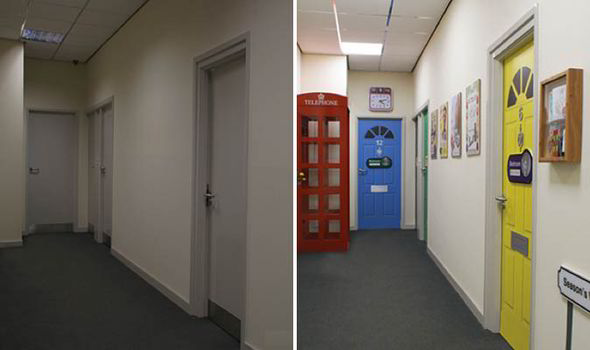How improving orientation for your residents living with a Dementia can help them to lead safer, more independent, and happier lives.Â
I would like you to imagine for a moment that you find yourself in a new unfamiliar building and you have spent the last ten minutes wandering aimlessly round a series of endless colourless corridors, all looking exactly the same, without any information to signpost you in the right direction. Oh and did I forget to mention, you are bursting to go to the loo!
 A very good example of a bare, unfriendly and frustrating corridor and a much brighter, well signed corridor.
A very good example of a bare, unfriendly and frustrating corridor and a much brighter, well signed corridor.
How do you think this would make you feel? Frustrated? Stressed? Confused?
But that’s okay because you’re confident and fully mobile, so you can find someone and ask for directions, right? Wrong! You are also infirm, uncommunicative, dependent, and you didn’t find that toilet in time.
Can you imagine the indignity and humiliation you would feel?
If you were living with a Dementia, disorientation and bewilderment could be a common experience for you, and you could feel very distressed and frightened.
According to the University of Stirling; ‘Many people living with Dementia have had to change where they live by, for example, going to live in a special housing unit or care home.
They could find it really hard to adjust to a new space, because adjustment needs memory and learning. It needs a capacity to work out where they are and how to behave.
They might see wavy lines moving, for example, or a change in floor colour as a step. These, combined with sight and hearing impairments can make the world a confusing, hostile and stressful place. No longer can they understand where things are. People can be shown where the toilet is, but next time they need to go, they can’t remember.
The environment can be made more supportive and enabling with quite simple additions. The first step is to make sure that what is important is highly visible.
There must be enough light and colour contrast to allow people to see properly.
Pictorial signs can be very helpful if they are clear, mounted low enough, contain words AND a picture and contrast with the background.
Signs can be directional with a finger or an arrow showing where to go, or can be on the door of a room.’
So here are some interesting facts for you:
Effective Dementia signage, used properly, WILL improve people’s safety and mobility by:
• Reducing incidents of incontinence
• Reducing agitation and aggression
• Reducing slips, trips and falls.
We know that CQC are focusing on ensuring that care environments support people with a Dementia as discussed in Cracks in the Pathway: Peoples’ experience of dementia care as they move between hospitals and care homes in 2014
‘Environment can have a significant impact on someone living with Dementia. It can cause anxiety and confusion, and make it difficult for people to orientate themselves.
We have seen examples where care homes and hospitals have made improvements to the environment to support good care. These include the use of pictorial signage and photographs to identify bedrooms and bathrooms’
We also have recent evidence and experience of this, where a care home customer of ours had been deemed to be ‘dementia unfriendly’ by CQC due to a lack of signage to help their residents navigate their way around the building.
We were able to complete a Dementia Environmental Audit for them, based on industry best practice, and identify and recommend various modifications to their environment, including a selection of high quality, robust and non-reflective dementia enabling signage. These signs also met their infection prevention and fire regulatory standards, and were developed in conjunction with the University of Sterling.
Investing in this signage system has enabled our customer to achieve:
• Compliancy with CQC
• Improved orientation for their residents
• Increased communication
• Reduction in slips, trips and falls
Investing in dementia enabling signage is the most cost-effective, long-term solution for providing reliable, visual orientation aids.
But how many signs are needed? (Too many can cause more confusion.)
Where do they need to be located? (There are definite right and wrong places)
What is the optimum height for recognition? (People with a dementia tend to walk with their heads down).
If you would like to receive your FREE copy of our Dementia Enabling Signage Essential Checklist email us on sales@hcsuk.couk or call Beckie on 01773 713713
If you would like more comprehensive advice, Hcsuk can provide this for you too.
We are offering you a Dementia Enabling Environmental Audit service:
We will provide an on-site survey of your environment
• You will receive recommendations and product solutions to improve your environment.
• You can source all the solutions you need from one company
Helping you to achieve:
• Compliancy with CQC
• Improved orientation for your residents
• Increased communication
• Reduction in slips, trips and falls
If you were living with a Dementia, would your drive for self-determination, dignity and living independently cease? – No, if anything, that desire would increase.
Good design, good signage and good advice combined, can go a long way towards improving quality of life for us all.
Could Health Care Services hold the key to enhancing your Dementia enabling environment?
To find out more about our Dementia Environmental Audit Service please contact Beckie today on 01773 713713 or email her at sales@hcsuk.co.uk




